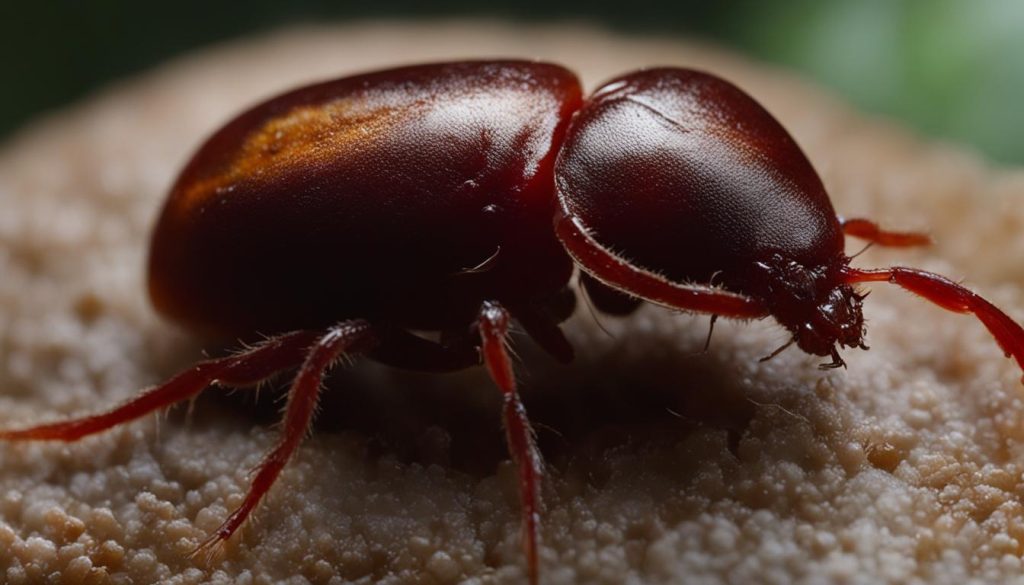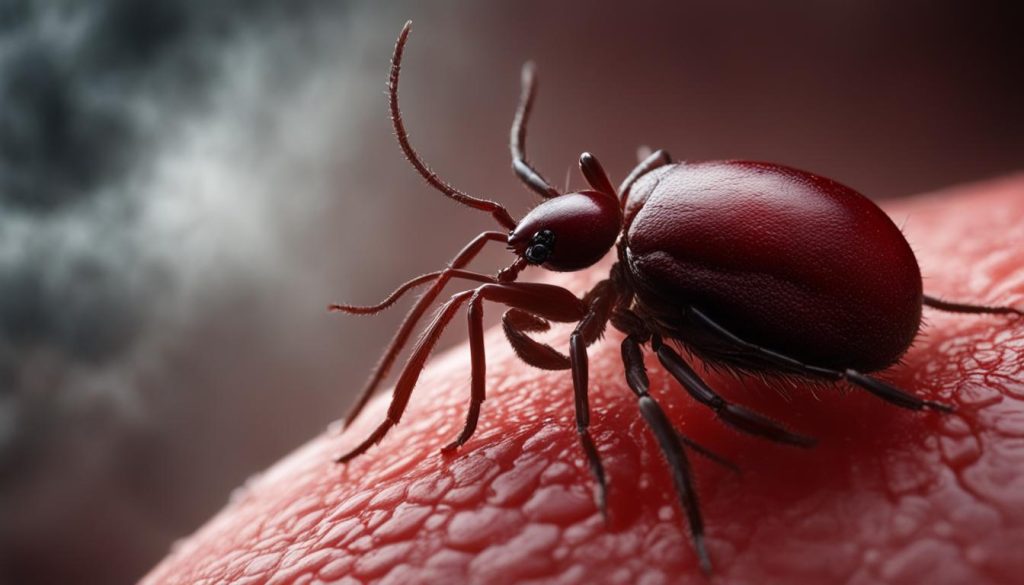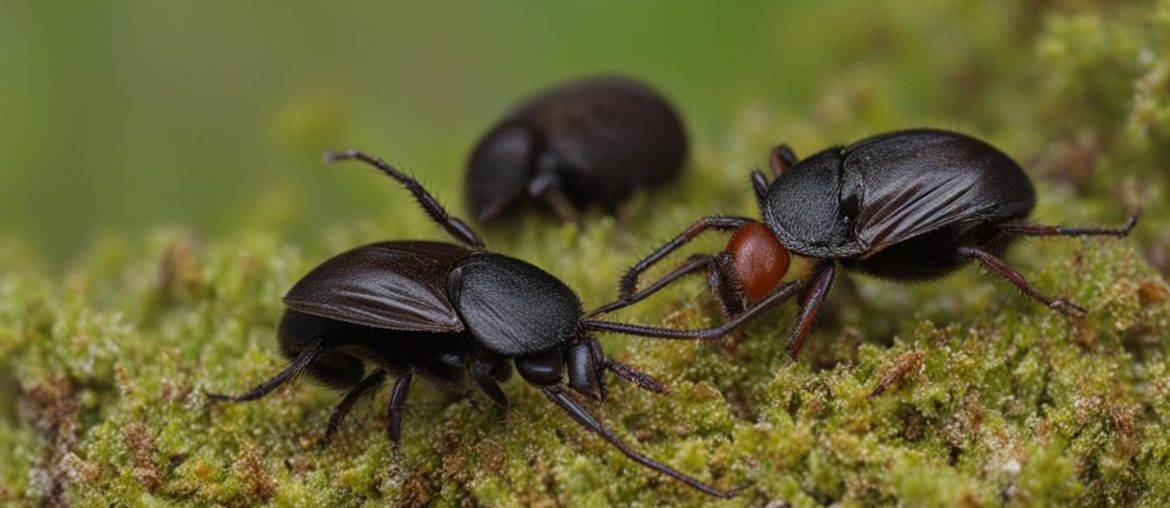Ticks are a common pest that can pose a threat to the health of our beloved dogs. These tiny bugs hide on dogs and feed off their blood, making them difficult to detect. However, knowing how to identify ticks is crucial in order to protect our furry friends.
Ticks come in various sizes, ranging from as small as a poppy seed to as large as a grape when engorged with blood. They have an oval-shaped body that is typically black or dark brown. As larvae, they have six legs, which then grow to eight legs as nymphs and adults. Ticks often attach themselves near a dog’s neck, head, ears, and in the creases under their legs. In some cases, ticks may appear as small skin lumps or cysts if they have been feeding for a while.
Regularly checking for ticks on your dog is essential, especially if they spend time outside in wooded or grassy areas. Being able to recognize the visual cues and characteristics of ticks can help you take the necessary actions to prevent tick-borne diseases.
Key Takeaways:
- Ticks on dogs can vary in size, from as small as a poppy seed to as large as a grape when engorged with blood.
- They have an oval-shaped body that is typically black or dark brown.
- As larvae, ticks have six legs, which then grow to eight legs as nymphs and adults.
- Ticks often attach themselves near a dog’s neck, head, ears, and in the creases under their legs.
- Checking your dog regularly for ticks is crucial to prevent tick-borne diseases.
In summary, ticks on dogs take on an oval-shaped appearance, ranging in color from black to dark brown. Their size can increase significantly when engorged with blood, and they may resemble warts or skin lumps. Regular grooming and meticulous inspection of your dog’s fur are essential for identifying ticks and ensuring their prompt removal.
How to Safely Remove a Tick from Your Dog
Ticks are pesky parasites that can latch onto your dog and cause various health issues. If you find a tick on your dog, it’s crucial to remove it safely and properly to avoid causing harm. Here’s a step-by-step guide on how to remove ticks from your dog:
- Prepare the necessary tools: Before removing the tick, gather a pair of tweezers or a tick removal tool. Make sure the tools are clean to prevent any infection.
- Restrain your dog: If your dog is skittish or anxious, have someone help you hold them steady during the tick removal process. This will ensure that neither you nor your dog gets injured.
- Locate the tick: Carefully examine your dog’s fur, paying close attention to areas like the neck, head, ears, and leg creases where ticks are commonly found.
- Grasp the tick: Using the tweezers or tick removal tool, grasp the tick as close to your dog’s skin as possible. Be steady and gentle to avoid squeezing the tick’s body.
- Remove the tick: Slowly and steadily pull the tick straight out, using a firm but gentle motion. Avoid twisting or jerking, as this can break the tick’s mouthparts and increase the risk of disease transmission.
- Clean the area: After successfully removing the tick, clean your dog’s skin with antiseptic or warm soapy water to reduce the risk of infection.
- Dispose of the tick: Place the tick in a sealed bag or a container filled with rubbing alcohol to ensure it doesn’t escape. Properly dispose of the tick in the trash.
Remember, it’s essential to monitor your dog after tick removal for any signs of infection or illness. If you notice any unusual symptoms, consult with your veterinarian for further guidance. Regularly check your dog for ticks and consider using tick prevention methods to keep your furry friend safe from future infestations.
| Tick Removal Tips | Do’s | Don’ts |
|---|---|---|
| Apply tick prevention treatment | Use tweezers or a tick removal tool | Twist or jerk the tick |
| Inspect your dog regularly | Grasp the tick close to the skin | Squeeze or crush the tick |
| Monitor your dog after removal | Pull the tick straight out | Use your bare hands |
| Clean the area with antiseptic | Dispose of the tick properly | Delay tick removal |
By following these safe tick removal methods, you can effectively protect your dog from the potential harm caused by ticks. Remember, prevention is key, so ensure your dog is on a regular tick prevention regimen recommended by your veterinarian.
Tick-Borne Diseases in Dogs
Tick-borne diseases pose significant health risks to dogs. Some of the most common tick-borne diseases in canines include Lyme disease, Ehrlichiosis, and Babesiosis. These diseases are caused by the transmission of bacteria or parasites through tick bites. It’s crucial for dog owners to be aware of these diseases and take preventive measures to protect their pets.
Table: Tick-Borne Diseases in Dogs
| Disease | Symptoms | Treatment |
|---|---|---|
| Lyme Disease | Skin lesion, stiffness, lameness, swollen joints, fatigue | Antibiotics, pain management |
| Ehrlichiosis | Fever, anemia, lethargy, weight loss | Antibiotics, blood transfusions |
| Babesiosis | Fever, pale gums, jaundice, weakness | Antiprotozoal medications, supportive care |
Lyme disease is perhaps the most well-known tick-borne disease. It is caused by the bacterium Borrelia burgdorferi and can lead to various symptoms, including a characteristic skin lesion, joint inflammation, and fever. Ehrlichiosis, on the other hand, affects white blood cells and can cause symptoms such as fever, anemia, and lethargy. Babesiosis, caused by the protozoan parasites of the genus Babesia, can result in symptoms like fever, pale gums, and weakness.
Please be aware that tick-borne diseases in dogs can have long-lasting effects if left untreated. Early diagnosis and prompt treatment are crucial to ensure the best possible outcomes. If you suspect that your dog may have been exposed to ticks or is showing any symptoms of tick-borne diseases, it’s important to consult with a veterinarian for proper diagnosis and treatment.
Prevention is key when it comes to tick-borne diseases in dogs. Regularly checking your dog for ticks, using tick prevention treatments recommended by your veterinarian, and avoiding tick-infested areas can help reduce the risk of your dog contracting these diseases. Additionally, maintaining good overall health for your dog through proper nutrition and regular veterinary check-ups can strengthen their immune system and make them less susceptible to tick-borne illnesses.
Preventing Tick Infestation in Dogs
Tick prevention is crucial for keeping your canine companion safe from tick-borne diseases. By following these tick control measures for dogs, you can significantly reduce the risk of tick bites and infestation.
1. Use Effective Tick Prevention Treatments
Consult with your veterinarian to determine the best tick prevention treatment for your dog. Options may include tick collars, tablets, or spot-on treatments. These products are designed to kill ticks and prevent infestation. Follow the instructions carefully and apply the treatment as recommended.
2. Regularly Check Your Dog for Ticks
After walks or outdoor activities, thoroughly inspect your dog’s fur for ticks. Pay close attention to areas like the neck, head, ears, and leg creases where ticks are commonly found. It can be helpful to brush your dog’s coat against the direction of hair growth to get a clear view of the skin. If you find a tick, remove it promptly and safely using a tick removal tool.
3. Use Tick Repellents on Pet Accessories
Consider using tick repellents on your pet’s accessories, such as bedding, blankets, and collars. These repellents can help deter ticks from attaching to your dog’s belongings and reduce the risk of infestation. Follow the instructions provided by the manufacturer for safe and effective use.
4. Maintain a Tick-Free Environment
Keep your garden’s grass short to discourage ticks from residing in your outdoor space. Trim any overgrown vegetation and clear leaf litter, as these areas can provide hiding places for ticks. Additionally, consider creating a tick barrier by placing gravel or wood chips between wooded areas and your lawn.
5. Seek Veterinary Advice in High Tick Activity Areas
If you live in an area known for high tick activity or are planning to travel to such an area, consult with your veterinarian for additional tick prevention advice. They can recommend specific measures and guide you on the best practices to protect your dog from tick infestation and tick-borne diseases.
By implementing these tick prevention measures, you can minimize the risk of tick bites and ensure the well-being of your furry friend.

| Tick Stage | Activity |
|---|---|
| Egg | Laid on the ground by female ticks in spring |
| Larva | Inactive for about a year, molt into nymphs |
| Nymph | Seek out a host, feed for several days, drop off and molt into adult ticks |
| Adult | Mate on a host, lay eggs, and complete the cycle |
Please be aware that tick activity varies depending on the region and environmental conditions. Some areas may have higher tick populations and increased activity throughout the year. If you live in an area known for high tick activity, it’s essential to take extra precautions and regularly check yourself, your pets, and your surroundings for ticks.
Tick-Borne Diseases in Humans
Ticks not only pose a threat to dogs but also to humans. These tiny creatures can transmit various diseases, with Lyme disease being the most common. When a tick bites a human and transmits the bacteria that cause Lyme disease, symptoms may include a red rash around the tick bite, flu-like symptoms such as headaches and muscle pain, and fatigue. It’s essential to seek medical attention if you suspect a tick bite and experience any of these symptoms.

To protect yourself from tick-borne diseases, there are several preventive measures you can take. When in areas known to have ticks, wear protective clothing such as long sleeves and pants to minimize exposed skin. Using insect repellents containing DEET or permethrin on your skin and clothing can also help repel ticks. After spending time outdoors, conduct thorough tick checks, paying close attention to areas like the scalp, behind the ears, under the arms, and around the waistline. Additionally, it’s advisable to shower and wash your clothing after outdoor activities to remove any unseen ticks.
Key Points:
- Tick bites can transmit diseases to humans, including Lyme disease.
- Symptoms of tick-borne diseases in humans may include a red rash, flu-like symptoms, and fatigue.
- Prevention measures for humans include wearing protective clothing, using insect repellents, conducting thorough tick checks, and showering after outdoor activities.
Table:
| Disease | Symptoms |
|---|---|
| Lyme disease | Red rash, flu-like symptoms, fatigue |
| Ehrlichiosis | Fever, headache, muscle aches, fatigue |
| Babesiosis | Fever, chills, fatigue, muscle aches |
Tick Prevention Tips for Humans
Protecting yourself against tick bites is essential to prevent tick-borne diseases. Here are some effective tick prevention tips:
- Wear protective clothing: Cover your body with long sleeves, pants, and socks when in areas known to have ticks. This minimizes skin exposure and reduces the chance of ticks attaching to your body.
- Use insect repellents: Apply DEET or permethrin-based repellents to exposed skin and clothing to repel ticks. Follow the instructions on the product label for proper application.
- Perform thorough tick checks: After spending time outdoors, conduct a meticulous check for ticks. Pay close attention to areas like the scalp, behind the ears, under the arms, and around the waistline. Ticks can be small and easily missed, so be thorough in your examination.
- Shower and wash clothing: Take a shower and wash your clothes after outdoor activities to remove any unseen ticks. Ticks can sometimes remain on clothing, so washing and drying at a high temperature can help eliminate them.
By following these preventive measures, you can significantly reduce the risk of tick bites and protect yourself from tick-borne diseases.

Quote:
Preventing tick bites is the best defense against tick-borne diseases. Taking simple precautions, such as wearing protective clothing and using repellents, can go a long way in safeguarding your health.
Table: Recommended Tick Repellents
| Product | Active Ingredient | Duration of Protection |
|---|---|---|
| Repellent A | DEET | Up to 8 hours |
| Repellent B | Permethrin | Up to 6 weeks on clothing |
| Repellent C | DEET + Picaridin | Up to 12 hours |
Using a combination of these prevention methods will help ensure your safety and reduce the risk of tick-related illnesses.
Wrapping Up
After learning about tick identification and the risks they pose to both dogs and humans, it’s clear that regular tick checks and prevention measures are crucial. By knowing how to identify ticks on your dog and implementing preventive measures, such as tick prevention treatments and grooming habits, you can help keep your furry friend safe from tick-borne diseases.
But it’s not just dogs who are at risk. Humans can also be affected by tick-borne diseases, like Lyme disease. That’s why it’s important for both dog owners and individuals spending time in tick-prone areas to take precautions. Wearing protective clothing, using insect repellents, and conducting thorough tick checks are essential for minimizing the risk of tick bites and associated health issues.
By staying vigilant, following tick prevention tips, and seeking veterinary or medical attention if necessary, you can protect both yourself and your pets from the dangers of ticks. Remember, prevention is key when it comes to tick-borne diseases. Stay informed, take action, and prioritize regular tick checks to ensure the well-being of your loved ones.
FAQ
What does a tick look like on a dog?
Ticks on dogs have small, flat, black or dark brown oval-shaped bodies. When engorged with blood, ticks can expand to the size of a small coffee bean. They have eight legs and may appear as warts or skin lumps if they have been feeding for a while.
What are the signs that my dog has a tick?
Signs that your dog has a tick include licking and chewing at a specific area on their body, red and inflamed skin around the tick bite, anemia, random scabs on the body, head shaking, tick paralysis, tick-borne diseases, and associated symptoms like fever, tiredness, shifting lameness, pale gums, and difficulty breathing.
What do ticks look like on dogs?
Ticks on dogs have small, flat, black or dark brown oval-shaped bodies. When engorged with blood, ticks can expand to the size of a small coffee bean. They have eight legs and are often found in areas like the neck, head, ears, and leg creases of dogs.
How do I safely remove a tick from my dog?
To safely remove a tick from your dog, use a specially designed tick removal tool, such as a tick twisting tool. Slide the tool between the tick and your dog’s skin, getting as close to the skin as possible. Twist the tool two to three times in the same direction until you feel the tick loosen. Lift the tool slowly, and the tick should stay in the hook. Dispose of the tick properly by placing it in rubbing alcohol or a sealed bag and then in the trash.
What are some tick-borne diseases in dogs?
Some tick-borne diseases in dogs include Lyme disease, Ehrlichiosis, and Babesiosis. Lyme disease can cause symptoms like a lesion around the bite, stiffness, lameness, swollen joints, inflamed lymph nodes, tiredness, fever, and loss of appetite. Ehrlichiosis affects white blood cells, while Babesiosis affects red blood cells.
How can I prevent tick infestation in my dog?
To prevent tick infestation in your dog, use effective tick prevention treatments recommended by your veterinarian, regularly check your dog for ticks, brush their fur against the direction of hair growth to get a clear view of the skin, carry a tick removal tool, use repellents on pet accessories, and keep your garden’s grass short.
What is the tick lifecycle and survival pattern?
Ticks have a three-year lifecycle, starting as eggs laid by female ticks in the spring. Once the eggs hatch into larvae, they remain inactive for a year while they develop. In the following spring, the larvae climb up foliage and wait for a host to attach themselves to. After feeding off a host’s blood for about a week, the tick drops onto the ground and molts into a nymph. The nymph then searches for another host to feed on before dropping again and molting into an adult tick. Adult ticks mate and lay eggs before dying off. Ticks are most active in the spring and autumn, but they can be found throughout the year.
What are some tick-borne diseases in humans?
Tick-borne diseases in humans include Lyme disease. Symptoms in humans may include a red rash around the tick bite, flu-like symptoms such as headaches and muscle pain, and fatigue.
How can I prevent tick bites as a human?
To prevent tick bites and reduce the risk of tick-borne diseases in humans, it’s important to wear protective clothing, use insect repellents containing DEET or permethrin, conduct thorough tick checks after spending time outdoors, shower and wash clothing after outdoor activities, and seek medical attention if you suspect a tick bite and experience any symptoms.
What are the overall tick identification and prevention tips for dogs and humans?
The overall tick identification and prevention tips for dogs and humans include regularly checking for ticks, using tick prevention treatments, safely removing ticks, being aware of tick-borne diseases and their symptoms, taking precautions in tick-prone areas, and seeking veterinary or medical advice when needed.






